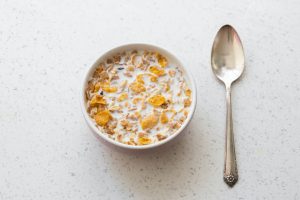Why is fibre so important in our diet? There are a whole host of reasons and it’s not just your gut that will thank you for eating enough of it. A regular lack of fibre in your diet can increase the risk of conditions such as heart disease, diabetes, obesity and bowel cancers.
What are the benefits of fibre?
- Acts as food for the healthy bacteria that live in our gut, and increased fibre intake increases the number and type of bacteria in the gut
- Increases the bulk in our stools, improving motility and transit through the bowel, resulting in a more regular bowel pattern and preventing constipation
- Helps keep us feeling fuller for longer
- Reduces risk of conditions such as diabetes, heart disease and bowel cancer
- Reduces bad cholesterol in our blood stream
Too little fibre can
- Slow bowel transit, leading to irregular bowel movements and constipation
- Increase risk of conditions such as heart disease, diabetes, obesity and bowel cancer
- A diet low in fibre can cause weight gain due to lack of bulk and fullness that a diet high in fibre provides
Whereas too much fibre can be problematic
- Worsen constipation if fluid intake is low
- Lead to abdominal bloating, pain and discomfort
- Increase bowel motility, leading to frequent bowel motions and sometimes diarrhoea
So what do diets low in fibre, very high in fibre and the recommended amount of fibre look like?
Low fibre diet (≈12g fibre)
Breakfast Cornflakes with glass of smooth orange juice (minimal fibre)
Mid-morning Banana
Lunch White bread sandwich (2 slices) with ham and mayonnaise
Mid-afternoon Handful of grapes
Dinner Fish breaded and portion of chips
Very high fibre diet (≈48g fibre) 
Breakfast Fruit smoothie made with 3 different fruits, oats (40g) and 1 heaped tbsp linseeds
Mid-morning Fruity flapjack and 1 orange
Lunch 300ml homemade vegetable soup and brown bread (2 slices)
Mid-afternoon Chopped strawberries, 1 heaped tbsp chia seeds and 2 tbsp natural yoghurt
Dinner Chicken breast, carrots, parsnip, peas and baked potato with skin
Supper Digestive biscuits x 2
Recommended amount of fibre diet (≈25g fibre) 
Breakfast Porridge oats (40g) with blueberries
Mid-morning 2 x kiwis
Lunch Brown bread sandwich (2 slices) with chicken and a side salad
Mid-afternoon Handful of grapes and walnuts (30g)
Dinner Brown rice (150g cooked weight), homemade chicken curry with peas, peppers and sweet potato
*Fruit, vegetable and salad portion sizes in the daily diet plans above are approximately 80g*
Of course, it isn’t a case of one size fits all when it comes to fibre, you’ll need to find what works for you. The guidelines vary worldwide but aiming for 20-35g of fibre each day is a good place to start.
If your intake is too low, you should try to increase it gradually by 5g per week to find the balance that’s right for you. Increasing it too quickly may result in some unpleasant digestive effects so ensure you do it gradually. One of the best ways to monitor your daily fibre intake is to use a diet tracker app. It’s also important to remember to drink enough water if increasing your fibre intake so as to avoid a traffic jam of fibre in the gut.
Fibre is nature’s superfood, embrace it.
©The Gut Experts 2021



